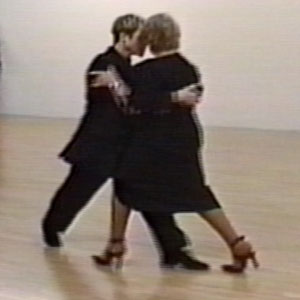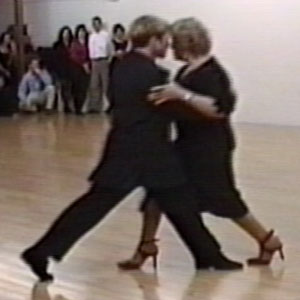These Amps Go to Eleven!
I used to practice taking the longest steps I could. Later, when I began to dance with Alej, I found that no matter how far I tried to stretch out my step, she was always able to match it. I’m taller than she is, and my legs are longer, but because of the A-frame connection, I would just carry her along with me. At the time, I never really thought about why I was doing it. I’m not sure where I got the idea that long steps were good. Maybe I picked it up from watching performers.


Pablo Pugliese stepping out with his mother Esther.
I began to think about step length last week when I heard someone say that they take big steps in milongas in Europe because there’s more space, but when they come to Buenos Aires, they need to take shorter steps. The implication was that long steps are better—something you just naturally want to do when you can. But is bigger really better? The theory of step length in tango isn't discussed very often, so let’s take a moment to talk about it.
Probably the silliest idea about step length is that it’s associated with a certain style of tango. Whenever I hear something like, “Villa Urquiza style tango is characterized by long steps and elegant dancing” it makes me smile. I picture some teacher saying, “You there! Stop dancing elegantly and taking those big steps. This is the Ugly Tango with Short Steps class—the Villa Urquiza workshop is tomorrow!”
It’s true that big steps usually look better—or at least they’re more eye-catching (which is probably why most performers and instructors like them). But stepping big just for the sake of stepping big... I'm not so sure. It reminds me of a movie called This Is Spinal Tap. Spinal Tap was a fake documentary about a rock group whose members were both musically and intellectually challenged. But fortunately, despite their limitations, they were able to find success by becoming "one of the loudest bands in England." (They were especially proud of the dials on their amplifiers: "See this amp? These dials go to 11! Most blokes only play at 10, but we play at 11... that's one louder!").
Like many of the really important things in tango, the answer is simple—but maybe not so obvious. If you think about it, taking the same size step all the time, long or short, is a lot like playing the same note over and over. What I've found is that as you dance more and become closer to the music, and as you become more aware of what the milongueros are doing around you, your step length will begin to vary in response to what you hear. If the orchestra goes, “tink-tink-tink”, then that’s what your step should do. And if the music goes “Wa-WHOOM!” that's a pretty good clue as well. The length of a tango step can be anywhere from zero to 1 meter, with an infinite number of points in between. As you begin to hear more layers of the music, you may find that you'll use more and more of them. And you may also find that no matter how crowded it gets, if you anticipate the music, you can almost always find space to stretch out and take a couple of really big steps when you need to.
Changing the length of a step doesn't require any great technical skill. It's within the reach of anyone who wants to dance, but it takes a lot of experience to do it well. It requires a good ear, and an awareness of the subtle connection between what you hear and how much energy you put into the step.